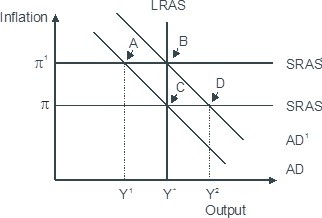According to the quantity theory of money, money growth and inflation are
A) positively correlated.
B) negatively correlated.
C) independent, that is, not correlated.
D) positively correlated if the inflation rate is positive and negatively correlated if the inflation rate is negative.
A
You might also like to view...
Based on the figure below. Starting from long-run equilibrium at point C, a tax cut that increases aggregate demand from AD to AD1 will lead to a short-run equilibrium at point ________ and eventually to a long-run equilibrium at point ________, if left to self-correcting tendencies. 
A. D; C B. B; C C. B; A D. D; B
Clarissa Kessler operates a store that sells toys. Her business suffered tremendously when a giant discount store chain opened a store in the area and is able to sell its products for less than Clarissa's wholesale cost
Is this evidence of illegal price discrimination on the part of the discount store chain? A) No, even if the price discrimination is based on differences in cost, the law states that it is not illegal. B) No, because it can be argued that the discount store chain is justified in charging lower prices because it is a large-volume buyer and is able to purchase toys at a lower wholesale price than Clarissa. C) Yes, it is clearly a violation of the Robinson-Patman Act. D) Yes, the discount store chain is engaging in predatory pricing.
Suppose Jack and Kate are at the town fair and are choosing which game to play. The first game has a bag with four marbles in it-1 red marble and 3 blue ones. The player draws one marble from the bag; if it is red, they win $20 and if it is blue, they win $1. The second game has a bag with 10 marbles in it-1 red, 4 blue, and 5 green. The player draws one marble from the bag; if it is red, they win $20; if it is blue, they win $5; and if it is green, they win $1. Both games cost $5 to play. Kate decides to play the second game. Kate's expected value of payoff is:
A. $5.00. B. $5.75. C. $4.50. D. $4.00.
Which of the following are considered ad valorem taxes?
A) taxes assessed by charging a rate equal to a percentage of an item's price B) taxes assessed by charging a flat amount per unit purchased C) taxes based on the amount of debt that the government must repay D) taxes based on the amount of spending the government will undertake